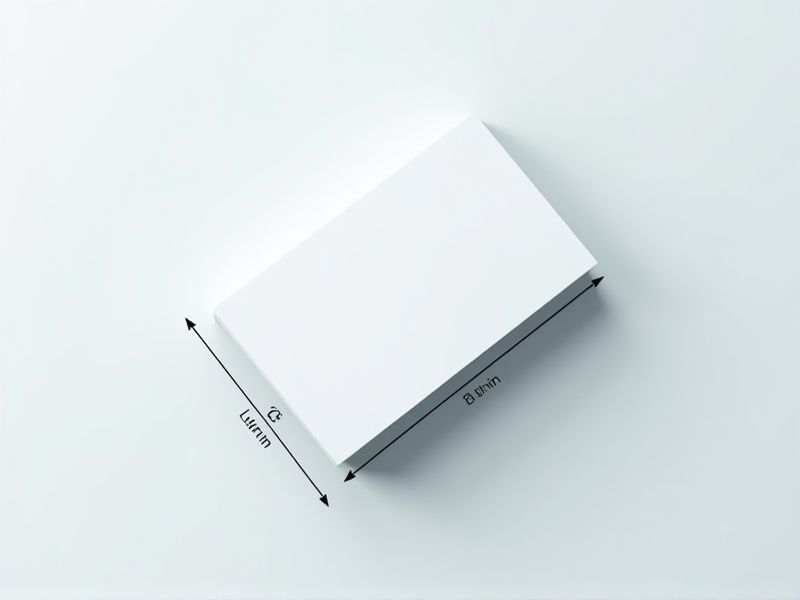
Business cards typically follow a standard dimension to ensure they fit easily into wallets and card holders. The most common size is 3.5 inches by 2 inches (88.9 mm by 50.8 mm), which is widely accepted in the United States and Canada. When designing your business card, it's important to keep these measurements in mind, as this size offers a professional look and practical convenience. Staying within standard dimensions also makes printing and distribution more straightforward for both individuals and printing companies.
Dimensions: 3.5 X 2 Inches
A standard business card typically measures 3.5 x 2 inches, making it a compact and convenient tool for networking. This size fits easily into wallets, cardholders, and pockets, ensuring that you can share your contact information effortlessly. In terms of design, adhering to this standard dimension allows for optimal use of space while maintaining readability. When creating your business card, consider including essential details such as name, title, phone number, email, and company logo for effective communication.
Aspect Ratio: 1.75:1
The standard aspect ratio for a business card is 1.75:1, meaning the width is 1.75 times greater than its height. This proportion ensures that the card is visually appealing and practical for handling, fitting easily into wallets and cardholders. Most business cards measure approximately 3.5 inches in width and 2 inches in height, adhering to this aspect ratio. By maintaining this standard, you enhance the likelihood of making a memorable impression on potential clients or partners.
Orientation: Landscape
A landscape-oriented business card typically measures 3.5 inches in width and 2 inches in height, providing a spacious layout for your information. This design choice allows for a visually balanced presentation, making it easier to include your name, title, and contact details without feeling cramped. Using a landscape orientation can enhance readability, especially when integrating logos or graphics, as the wider format draws the eye across the card. For maximum impact, opt for high-quality cardstock with finishes that complement your branding, ensuring your business card not only conveys information but also leaves a lasting impression.
Printable Area: Full Bleed Allows Slight Overprint
The standard business card size is typically 3.5 inches by 2 inches, with an optimal printable area that extends to the edges for a full bleed design. This allows for a slight overprint, ensuring that colors and images reach the card's edge without any white margins. When designing your card, aim for a minimum of 1/8 inch bleed beyond the trim line to prevent any unintended borders during cutting. Using high-resolution images and a professional design template can enhance the overall aesthetic, making your card visually striking and memorable.
Margins: Maintain Safe Zone For Text
When designing your business card, ensure a safe margin of at least 1/8 inch (0.125 inches) around the edges to prevent text and important details from being cut off during printing. This standard margin creates a visual buffer, enhancing overall aesthetics and readability. Utilizing a 3.5 x 2 inches size, you can comfortably fit your name, title, contact information, and logo without overcrowding. By adhering to these margins, you enhance the professionalism of your card, increasing the likelihood of leaving a positive impression on potential clients.
Paper Thickness: Usually 14Pt To 16Pt
A typical business card measures between 14pt and 16pt in thickness, ensuring durability and a professional appearance. Choosing a thickness within this range contributes to a tactile experience that can leave a lasting impression on potential clients. Cards made from 16pt paper offer a sturdier feel, while 14pt cards can provide flexibility. Selecting the right thickness not only impacts the card's aesthetic but also reflects your brand's commitment to quality and attention to detail.
Metric Equivalence: 88.9 X 50.8 Mm
The standard business card measures 88.9 x 50.8 mm, ensuring compatibility in various professional settings. This size, equivalent to 3.5 x 2 inches, is widely recognized for its practicality and ease of storage in wallets or cardholders. When designing your card, consider including essential elements such as your name, contact information, and business logo to enhance impact. Using quality cardstock can also elevate the tactile experience, making your card memorable to potential clients or partners.
Standard Shape: Rectangular
The standard shape for business cards is rectangular, measuring 3.5 inches by 2 inches, which is the most widely accepted format. This size easily fits into wallets and cardholders, ensuring convenient storage and access. Rectangular business cards also provide ample space for essential information, such as your name, title, and contact details, promoting effective networking. Your choice of high-quality cardstock further enhances the professional appearance of this standard shape, making a lasting impression.
Custom Shapes: Die-Cut Options Available
Custom-shaped business cards offer unique die-cut options that enhance your brand's visibility and memorability. These cards can be designed in various forms, allowing for innovative designs that reflect your business identity, whether it's a rounded corner, intricate cut-out, or completely bespoke shape. With these custom options, you can stand out in a competitive market, as 72% of people remember the shape of a business card over standard rectangular designs. Choose custom die-cuts to create a lasting impression and foster meaningful connections with your audience.
Compatibility: Fits In Most Wallets And Cardholders
A standard business card typically measures 3.5 x 2 inches, ensuring it fits seamlessly into most wallets and cardholders. This compact size facilitates easy storage and accessibility, making it convenient for networking opportunities. A well-designed business card also enhances brand representation, often featuring your logo and contact information prominently. Opting for high-quality cardstock can further increase durability, ensuring that your card retains its appearance over time.
